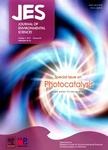Determining short chain fatty acids in sewage sludge hydrolysate: A comparison of three analytical methods and investigation of sample storage effects
Determining short chain fatty acids in sewage sludge hydrolysate: A comparison of three analytical methods and investigation of sample storage effects作者机构:VA SYD SE-201 21 Malmo Sweden Water and Environmental Engineering Department of Chemical Engineering Lund University SE-21100 Lund Sweden
出 版 物:《Journal of Environmental Sciences》 (环境科学学报(英文版))
年 卷 期:2014年第26卷第4期
页 面:926-933页
核心收录:
学科分类:083002[工学-环境工程] 0830[工学-环境科学与工程(可授工学、理学、农学学位)] 08[工学]
基 金:VA SYD for funding this project
主 题:five pH point titration gas chromatography spectrophotometry short chain fatty acids sludge hydrolysis sample storage
摘 要:In anaerobic digestion, the production of short-chain fatty acids (SCFAs) can be beneficial or harmful to the overall process, depending on the concentration of accumulated acids. Therefore, the accurate determination of the SCFA concentration in both fresh and stored sludge hydrolysates is important. To select a suitable method for monitoring SCFAs during the anaerobic digestion of sewage sludge, the accuracy of three available analytical methods, including 5 pH point acid titration (TITRA5), gas chromatography (GC), and spectrophotometry, were compared in the present study. The results revealed that TITRA5 and GC displayed better agreement in the achieved measurements and higher precision and accuracy than the spectrophotometric assay, as supported by the application of different statistical models. TITRA5 excelled in titrating unfiltered hydrolysate while simultaneously measuring the alkalinity, whereas the GC method provided detailed information on the contribution of different fatty acids to the total acidity. In contrast, the spectrophotometric assay suffered from many forms of interference, depending on the sample's matrix. SCFA production followed the pattern of enzymatic reactions and fitted the Michaelis-Menten model. In addition to promoting TITRA5 as an accurate and robust analytical tool for routine SCFA analyses, this comparative study also demonstrated the possibility of storing hydrolysate samples at different temperatures and durations without altering the SCFA measurements.



